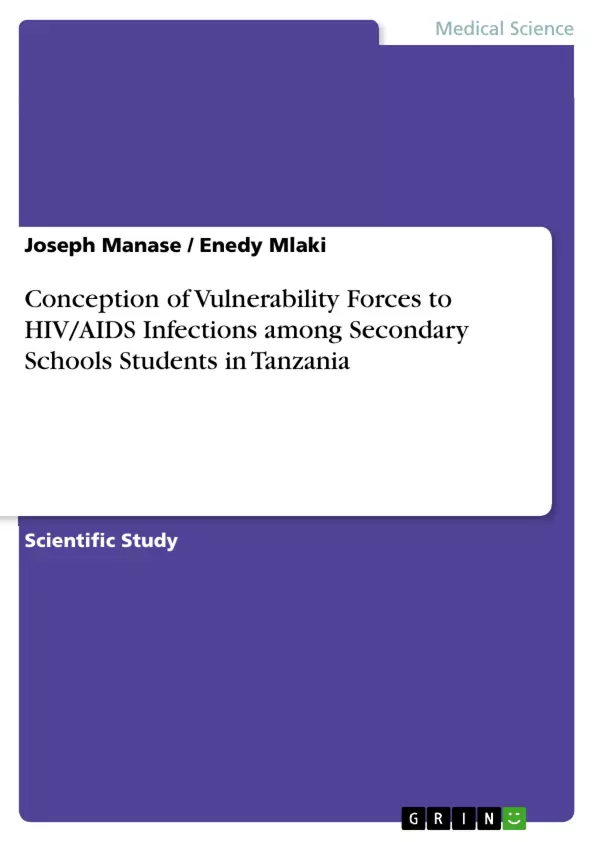ABSTRACT
The study designed to assess forces for vulnerability to HIV/AIDS infections among secondary schools students in Dodoma Municipality. Cross sectional survey was employed. Both probability and non probability techniques were used to obtain the sample. Objectives of the paper were to determine vulnerability forces to HIV/AIDS infection among students in Dodoma Municipal and identification of risk behaviors that lead to HIV/AIDS infection in the study location. Data analysis was done by statistical package for social science (SPSS) computer soft ware. The findings show that vulnerability forces leading to HIV/AIDS infection among students are among others, lack of awareness and drug abuse, High rate of HIV infection through blood transfusions and widespread sharing of contaminated injecting equipments were the risk forces for HIV/AIDS spread. Some media disseminates HIV/AIDS miss-information, prejudice and myth. Drug abuse, poverty, adolescence stage, peer group, ignorance, carelessness of the students and engagement in sexual intercourse were the main forces for HIV/AIDS spread. Finally it was recommended that Counseling agencies for HIV/AIDS to assist Peer group/friends, the community to fight against Female Genital Mutilations, agencies to disseminate HIV education to secondary students to increase their awareness. The government should empower the community economically for Poverty reduction. Integration of HIV/AIDS education in all social subjects curricula to be a must.
Key words: vulnerability forces, HIV/AIDS, secondary school students, media, dissemination, education
Inhaltsverzeichnis (Table of Contents)
- Introduction
- Reviewed Literature
- Vulnerability of HIV/AIDS among Students at Global Level
- Vulnerable Populations at Greatest Risk
- Methodology
- Study Design
- Study Population
- Sample Size and Sampling Techniques
- Data Collection Tools and Procedures
- Data Analysis
- Findings and Discussion
- Conclusions and Recommendations
Zielsetzung und Themenschwerpunkte (Objectives and Key Themes)
This study aims to investigate the vulnerability factors leading to HIV/AIDS infection among secondary school students in Dodoma, Tanzania. It seeks to identify the main factors contributing to their vulnerability and the risk behaviors associated with HIV/AIDS transmission in the region.
- Factors contributing to vulnerability to HIV/AIDS among secondary school students in Dodoma.
- Risk behaviors associated with HIV/AIDS transmission.
- Sources of HIV/AIDS information for students.
- Impact of social-cultural factors on HIV/AIDS vulnerability.
- Effectiveness of existing HIV/AIDS education programs.
Zusammenfassung der Kapitel (Chapter Summaries)
- Introduction: This chapter provides an overview of the global HIV/AIDS pandemic, highlighting its impact on young people, particularly in developing countries like Tanzania. It also introduces the research question and the specific objectives of the study.
- Reviewed Literature: This chapter reviews existing literature on HIV/AIDS vulnerability among students, exploring various global perspectives and highlighting the challenges of preventing HIV/AIDS transmission in different contexts. It also emphasizes the need for targeted interventions to address the unique vulnerabilities faced by young people.
- Methodology: This chapter outlines the research design, population, sampling techniques, data collection methods, and data analysis procedures employed in the study.
Schlüsselwörter (Keywords)
This study focuses on the vulnerability forces, HIV/AIDS, secondary school students, media dissemination, and education in the context of HIV/AIDS prevention and intervention in Tanzania. It explores the complex interplay of social, cultural, and economic factors influencing the spread of HIV/AIDS among young people and the effectiveness of existing educational programs.
- Arbeit zitieren
- Joseph Manase (Autor:in), Enedy Mlaki (Autor:in), 2012, Conception of Vulnerability Forces to HIV/AIDS Infections among Secondary Schools Students in Tanzania, München, GRIN Verlag, https://www.grin.com/document/195879



